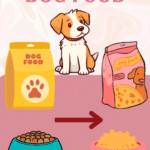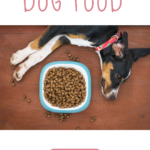There are a couple of times in your pet parent journey where you may need to switch your dog’s food to a new one. The best way to transition dog food is to gradually mix increasing amounts of the new food with decreasing amounts of the old food until the old food is transitioned out. This should be done over the course of about a week to prevent diarrhea and stomach upset.
Studies have found that dog parents switch food for three main reasons: to achieve a certain health outcome, because the food is too expensive, or because the dog dislikes the previous food. Whether your reason is included here or not, switching dog food slowly and comfortably for your dog is extremely important.

A Step-by-Step Guide to Switching Dog Food
Once you have your new dog food, it’s time to make the switch—but you shouldn’t just remove your dog’s old diet entirely and put them on the new one, as an abrupt change in a dog’s diet can cause gastrointestinal upset, usually resulting in diarrhea and vomiting.
Here’s how to transition dog food safely.
1. Plan a Week to Make the Switch
Ideally, switching your dog’s food should be done over the course of a week to allow them time to adjust to the new food. Keep the old food on hand, and don’t wait until the bag runs out to start making the switch, as you won’t have enough food left to do it slowly and safely.
2. On Day One, Start to Sprinkle in the New Food
On the first day of changing dog foods, start to sprinkle in the new food with your pet’s current food. Around 10% of the new food to 90% of the current food is a good start, as you don’t want to do too much.
3. Keep Adding More of the New Food
Over the course of the week, keep adding in more of the new food. Go from around 10% on the first day, to 20% on the second, to 30% on the third. (This is just a rough estimate—you don’t need to be exact, as long as you’re moving gradually.)
4. By the Seventh Day, Feed Your Dog the New Food
By the time it gets to the end of the week, switching dog foods should have reached a successful conclusion with minimal upset! A gradual transition is the key to a safe and comfortable change.
Choosing a New Dog Food
Part of the focus should be on not just the process, but on finding a new food to switch to. Not all dog food is created equal, and some considerations include:
- The price of the new food
- The ingredients
- Who the new food is intended for (puppies, senior dogs, dogs with sensitive stomachs, etc.)
- The availability of the new choice
- Wet vs. dry food
It’s also important to do some online research to find out if the food has had any recalls or if it’s been linked to health issues. For example, the FDA found that certain diets have been linked to canine dilated cardiomyopathy, mostly foods labeled as grain-free.
If you’re unsure about the best dog foods, you can also ask your veterinarian for their advice. They know your dog and their health history and will be able to recommend a diet specifically tailored to their needs, as well as watch out for any allergies and intolerances should they happen.
How Long Does a Dog Usually Have Diarrhea After Changing Food?
During the switch, your dog may have a little diarrhea or signs their stomach is adjusting. As long as this only happens once or twice and your dog shows no other issues, you can keep monitoring them (and perhaps take the transition slower) but they should be okay. Probiotics can also help.
If the symptoms don’t resolve themselves after two days, or they seem severe (very runny diarrhea, vomiting more than once), you should speak to your veterinarian, as they may have food intolerance or food allergies.
Switching Between Wet Food vs. Dry Food
If you’re planning to change your dog’s food from wet to dry (or vice versa), you should still follow the same approach. If switching to wet food, you can use the food as a topper; if switching to dry, mix it into the old wet food in the same manner as above.
Final Thoughts
When switching to senior dog food or adult dog food, making a diet transition can be a little daunting for dog owners, but as long as you take it slow and keep an eye on your pet for any signs of stomach upset, they should be fine.
Stick to a gradual transition and ensure you research the pet food before committing to it, to ensure your dog is getting the best.



